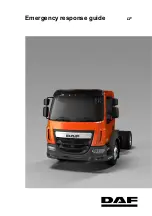
REAR SUSPENSION 4B-26
installed on frame and are contacted by the auxil
iary spring to provide added stability required for
unusual conditions.
SHOCK ABSORBERS
Shock abs.. rbers, used as standard or optional
equipment on some vehicles, are non-adjustable
and non-repair able. Maintenance operations are
limited to replacement of rubber mounting grom-
mets and periodically tightening all mountings. If
a shock absorber becomes inoperative, the com
plete unit must be replaced.
C A U J IO N : When replacing a shock absorber,
check the model number stamped on the unit to
make sure it is the same model as the one removed.
Figure
7— Installing Spring
Eye
Bushing
HENDRICKSON TANDEM REAR SUSPENSION
DESCRIPTION
In the Hendrickson R T and RU type sus
pension equalizing beams are used to tie front and
rear axles together,
and permit independent
vertical movement of each axle as required by
road surface. Road shocks are partially absorbed
through use of rubber bushings at beam center,
ends, and torque arms. Driving and braking forces
are transmitted to the vehicle chassis through
adjustable or solid torque rods and the equalizer
beams. The springs carry the load and maintain
transverse relationship of frame to axle. Torque
rods are positioned to maintain proper drive line
alignment and stabilize driving and braking forces.
The basic difference between the R T and RU-type
suspension is that the RT-type embodies a spring
top saddle pad that uses bolts in place of U-bolts
to secure spring to axle. Also on conventional
models front torque rod is adjustable, whereas the
RU-type employs solid front and rear torque rods
and uses U-bolts to secure springs to axle. Steel
tilt cab models use adjustable torque rods at front
and rear positions on RT-type and adjustable rear
rod on RU-type. Figures 8 and 9 show typical
arrangement of Hendrickson suspension units de
scribed.
The Hendrickson RS 380
suspension
shown in figure 11 uses rubber load cushions to
absorb load and road shock. The rubber load
cushion is an innovation in tandem suspensions
wherein the rubber replaces the normally used
steel leaf spring. Positive mounting between the
frame and the suspension unit is secured by four
rubber bushed drive pins, one for each load
cushion. These bushings permit the drive pins to
move up and down in direct relation to the move
ment of the load cushion. Figure 10 shows a cut
away of the load cushion with the suspension
system under full load.
Periodic lubrication has been fully eliminated
by the use of the rubber load components.
TANDEM UNIT REMOVAL
AND INSTALLATION
When a major overhaul is required, the com
plete tandem unit should be removed from the
CHEVROLET SERIES 70-80 HEAVY"
D U T Y T R U C K
SH O P M A N U A L
Summary of Contents for 70 1969 Series
Page 1: ...CHEVROLET HEAVY DUTY TRUCK SHOP MANUAL...
Page 3: ......
Page 11: ...LUBRICATION 0 4 CHEVROLET SERIES 70 80 HEAVY DUTY TRUCK SHOP MANUAL...
Page 27: ......
Page 119: ......
Page 361: ......
Page 371: ......
Page 427: ......
Page 443: ......
Page 451: ......
Page 493: ......
Page 499: ......
Page 549: ......
Page 555: ......
Page 609: ......
Page 715: ...am...
Page 745: ......
Page 910: ......
Page 913: ......








































